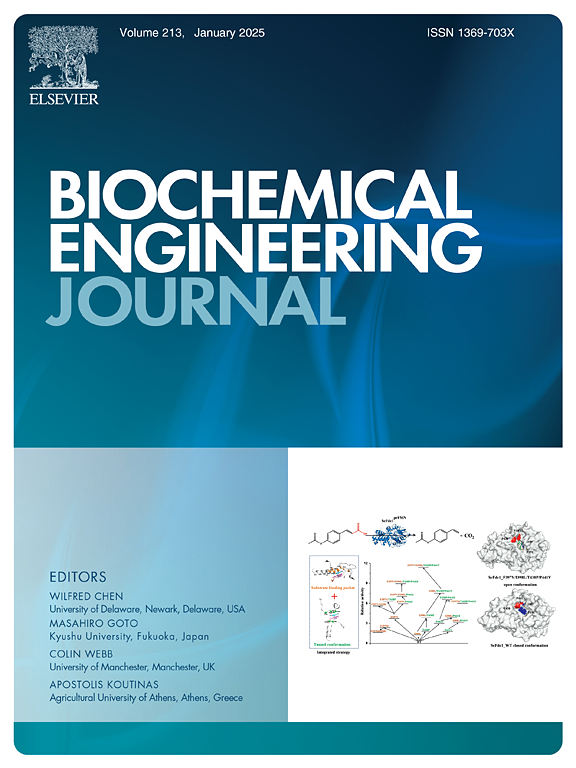甘蔗生物精炼厂中1,2-丙二醇的直接微生物生产:技术发展带来的经济和环境效益
IF 3.7
3区 生物学
Q2 BIOTECHNOLOGY & APPLIED MICROBIOLOGY
引用次数: 0
摘要
1,2-丙二醇(1,2- pdo)是一种广泛使用的化学品,具有多种工业用途。间接生物基方法为石化过程提供了一种可持续的替代方法,但受到能源密集型和复杂转化过程的阻碍。直接基于生物的1,2- pdo方法可以克服这些挑战,但需要额外的菌株和生物工艺改进。本研究量化了与化石基替代品相比,直接生物基1,2- pdo实现理想的财务和环境结果所需的技术性能。利用Aspen Plus®软件模拟了集成甘蔗生物精炼厂中1,2- pdo的直接生物基生产。通过技术经济和环境评估,对反应蒸馏(S1-PDO-RD)和液液萃取(S2-PDO-LLE)两种下游工艺方案进行了评估,以解决工艺能源效率低下的问题。在目前的生物转化能力下,S2-PDO-LLE的MSP比S1-PDO-RD低8.7% %,温室气体排放量多2.2% %,但两种方案在经济上都不可行。通过提高生物转化效率,S2-PDO-LLE可以实现比基于化石的1,2- pdo价格低19.9 %的MSP,比商业方法减少48.5 %的温室气体排放量。同样,S1-PDO-RD可以以10.7% %的温室气体排放量略微优于基于化石的方法。析因分析表明,LLE可以通过提高菌株和生物工艺性能来提高生存能力,应优先用于1,2- pdo下游处理。由于具有更高的能源效率和减少对产量特定化学品的依赖,直接生物基方法具有超越现有石化方法的巨大潜力。本文章由计算机程序翻译,如有差异,请以英文原文为准。
Direct microbial production of 1,2-propanediol in a sugarcane biorefinery: Financial and environmental benefits from technology development
1,2-propanediol (1,2-PDO) is a widely used chemical with various industrial applications. Indirect biobased methods provide a sustainable alternative to petrochemical processes but are hindered by the energy-intensive and complex conversion processes. Direct biobased 1,2-PDO methods could overcome these challenges but require additional strain and bioprocess improvements. The present study quantified the technical performances required to achieve desirable financial and environmental outcomes for direct biobased 1,2-PDO compared to the fossil-based alternative. The direct biobased production of 1,2-PDO in an integrated sugarcane biorefinery was simulated using Aspen Plus® software. Two downstream processing options, reactive distillation (S1-PDO-RD) and liquid-liquid extraction (LLE) (S2-PDO-LLE), were evaluated to address process energy inefficiencies through techno-economic and environmental assessments. S2-PDO-LLE had an 8.7 % lower MSP with 2.2 % more GHG emissions than S1-PDO-RD at current bioconversion capacity, but neither scenario was economically viable. With improved bioconversion efficiencies, S2-PDO-LLE could achieve an MSP that is 19.9 % lower than the fossil-based 1,2-PDO price with 48.5 % fewer GHG emissions than the commercial method. Similarly, S1-PDO-RD could narrowly outperform the fossil-based method with 10.7 % lower GHG emissions. The factorial analysis indicated that LLE amplifies the viability gains achievable through improved strain and bioprocess performances and should be prioritized for 1,2-PDO downstream processing. Direct biobased methods have high potential to outperform incumbent petrochemical methods due to better energy efficiency and reduced reliance on yield-specific chemicals.
求助全文
通过发布文献求助,成功后即可免费获取论文全文。
去求助
来源期刊

Biochemical Engineering Journal
工程技术-工程:化工
CiteScore
7.10
自引率
5.10%
发文量
380
审稿时长
34 days
期刊介绍:
The Biochemical Engineering Journal aims to promote progress in the crucial chemical engineering aspects of the development of biological processes associated with everything from raw materials preparation to product recovery relevant to industries as diverse as medical/healthcare, industrial biotechnology, and environmental biotechnology.
The Journal welcomes full length original research papers, short communications, and review papers* in the following research fields:
Biocatalysis (enzyme or microbial) and biotransformations, including immobilized biocatalyst preparation and kinetics
Biosensors and Biodevices including biofabrication and novel fuel cell development
Bioseparations including scale-up and protein refolding/renaturation
Environmental Bioengineering including bioconversion, bioremediation, and microbial fuel cells
Bioreactor Systems including characterization, optimization and scale-up
Bioresources and Biorefinery Engineering including biomass conversion, biofuels, bioenergy, and optimization
Industrial Biotechnology including specialty chemicals, platform chemicals and neutraceuticals
Biomaterials and Tissue Engineering including bioartificial organs, cell encapsulation, and controlled release
Cell Culture Engineering (plant, animal or insect cells) including viral vectors, monoclonal antibodies, recombinant proteins, vaccines, and secondary metabolites
Cell Therapies and Stem Cells including pluripotent, mesenchymal and hematopoietic stem cells; immunotherapies; tissue-specific differentiation; and cryopreservation
Metabolic Engineering, Systems and Synthetic Biology including OMICS, bioinformatics, in silico biology, and metabolic flux analysis
Protein Engineering including enzyme engineering and directed evolution.
 求助内容:
求助内容: 应助结果提醒方式:
应助结果提醒方式:


